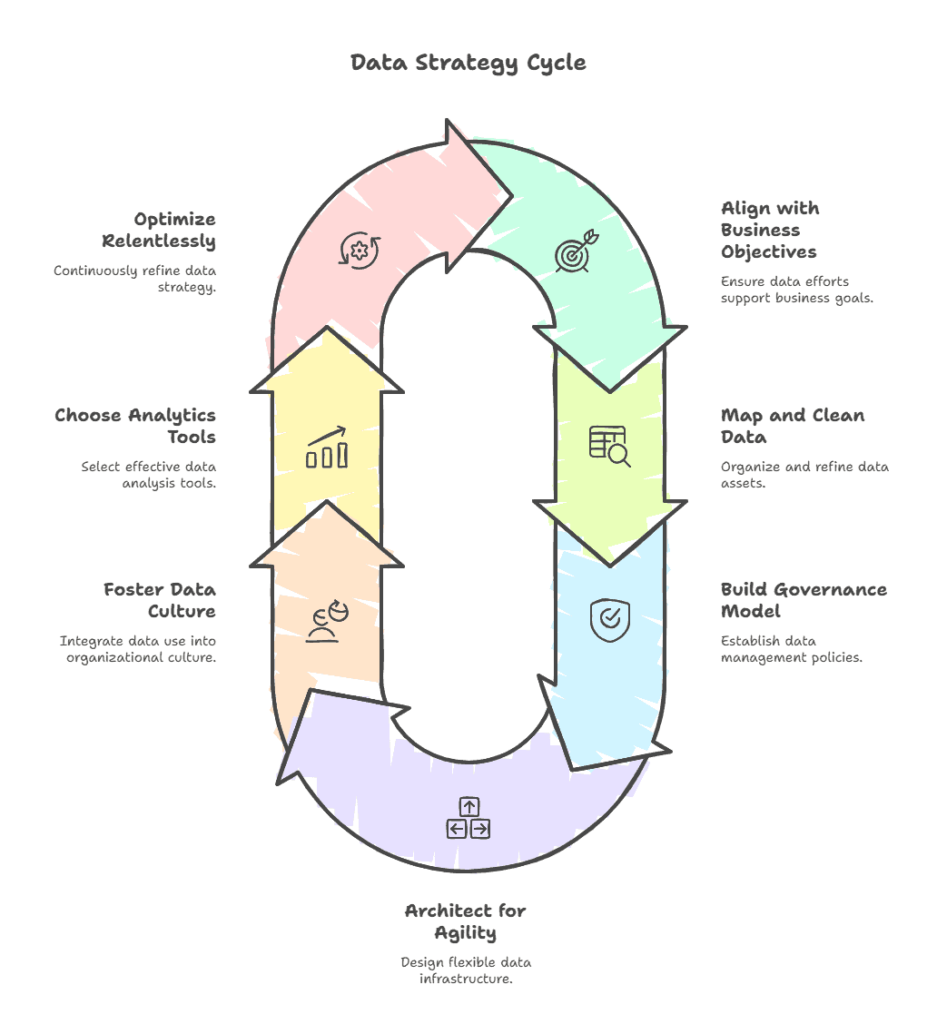Despite data being one of today’s most valuable business assets, most organizations are still treating it as an afterthought. According to a recent study, only 30% of organizations have a well-defined data strategy—a gap that often leads to inefficiencies, missed revenue opportunities, and misaligned decisions at every level of the enterprise.
In a world driven by insights, that’s no longer sustainable.
| “A data strategy isn’t a nice-to-have. It’s the blueprint for how your business will survive, compete, and evolve in a digital-first economy,” – Brian Leger, Co-Founder of InfoTECH Solutions |
This article breaks down how to build a winning data strategy framework—one that aligns your technology, people, and processes to unlock true data value. Whether you’re starting from scratch or refining your existing approach, this guide offers a clear path forward.
7 Proven Strategies That Turn Disorganized Data into Business Intelligence
Too many businesses are sitting on a goldmine of data, but without a clear plan, it’s just digital clutter. These seven strategies are your blueprint to turn data into decisive action—and they’re built to grow with you. Let’s dig into what really moves the needle when it comes to building a winning data strategy framework.
1. Tie Every Data Move to a Business Objective
Why it matters:
Your data should never exist in a vacuum. If it’s not driving a goal—revenue, efficiency, retention—it’s noise.
What to do:
- Meet with department heads and document key priorities (e.g., faster order fulfilment, better churn prediction).
- Translate these into measurable goals, such as “Reduce cart abandonment by 15%,” “Improve supply chain visibility by 20%,” etc.
- Use these goals to define what data you need and how often you need it.
Every dataset should answer a business question. If it doesn’t, you probably don’t need it.
Struggling to Make Sense of Your Business Data?
Partner with a trusted MSP that builds clarity and results into every data strategy.
Start Here2. Map and Clean Your Current Data Bucket
Why it matters:
You can’t manage what you don’t know exists. Unstructured, siloed, or outdated data kills momentum.
What to do:
- Conduct a full data inventory. Include customer data, financials, marketing analytics, support logs—everything.
- Flag duplicates, outdated fields, and inconsistencies. Automate cleanup where possible.
- Create a visual data map (tools like Lucidchart or Miro are great here).
Prioritize fixing high-impact data sources first, such as customer or sales data that directly influences your bottom line.
3. Build a Strong, Sustainable Data Governance Model
Why it matters:
Data governance has a bad rap—but without it, you risk breaches, compliance fines, and messy decision-making.
What to do:
- Assign data owners and define roles: who enters, manages, validates, and uses which data.
- Set clear policies for data access, updates, and deletions.
- Ensure compliance: If your business handles sensitive information, align your governance policies with regulatory authorities.
Keep everything simple and efficient. Governance should empower teams rather than create obstacles.
4. Architect for Agility and Scale
Why it matters:
Your business will evolve, and so will your tech stack. Your data architecture must be prepared for these changes.
What to do:
- Choose flexible data storage: cloud-first platforms like Azure, AWS, or Google Cloud.
- Use ETL/ELT tools to streamline integration (e.g., Fivetran, Talend).
- Build APIs that connect your key platforms (CRM, ERP, support, etc.) into a single source of truth.
Designing for real-time data processing is essential, as it’s quickly becoming a fundamental requirement.
5. Make Data Part of Your Culture, Not Just Your Stack
Why it matters:
You can’t be a data-driven organization if only the IT team knows how to use the dashboards.
What to do:
- Train staff on basic data literacy—how to interpret dashboards, how not to be misled by vanity metrics.
- Set team-specific metrics. Sales should see pipeline health. Marketing should track lead conversion rates. Ops should see workflow bottlenecks.
- Build a no-blame culture around experimentation and learning from data.
Start meetings with data. Use dashboards to standardize information and guide decision-making.
| Learn More About How You Can Enhance Your IT Capacity How to Navigate a Successful IT Integration in Mergers & Acquisitions 7 IT Procurement Best Practices You Need to Follow Managed Services vs Staff Augmentation: A Detailed Comparison |
6. Choose Analytics Tools That Empower (Not Overwhelm)
Why it matters:
The most effective analytics tool is the one that your team will actively use.
What to do:
- Start simple: Looker Studio (formerly Google Data Studio), Power BI, or Tableau are great entry points.
- Build role-based dashboards. A CFO and a marketing director shouldn’t see the same KPIs.
- Include predictive analytics as your next phase, especially for forecasting demand or customer churn.
Don’t chase AI hype unless your team has the maturity to act on the outputs.
7. Optimize Relentlessly—Data Strategy Is Never “Done”
Why it matters:
Business goals change, and customer behavior evolves. Your strategy needs to adapt; otherwise, it risks becoming obsolete.
What to do:
- Set quarterly data reviews. Compare KPIs to actual results. Identify what worked and what didn’t.
- Use feedback loops—get input from users interacting with the data daily.
- Tweak tools, retrain teams, and archive what’s no longer relevant.
The best strategies evolve faster than your competitors.

Bridge the Gap Between Strategy and Execution with a Data Operating Model
Many organizations create a well-documented data strategy but struggle to implement it consistently across departments. A Data Operating Model (DOM) closes this gap. It defines how data strategy becomes operational reality—who does what, with what tools, on what timeline, and under what metrics.
What it looks like in practice:
- Organizational alignment: The DOM outlines roles, responsibilities, and workflows across IT, operations, finance, and marketing—ensuring everyone executes against the same objectives.
- Technology enablers: It clarifies which tools support each layer of the strategy—data ingestion, transformation, visualization, and security.
- Processes and cadence: It establishes how often data is reviewed, who signs off on changes, and how new initiatives (e.g., launching a new dashboard or AI model) are evaluated.
- Performance metrics: KPIs within the DOM track strategic execution. These include data quality scores, usage rates of BI tools, policy adherence, and business impact metrics (like improved forecasting accuracy or campaign ROI).
This alignment builds resilience and creates a foundation for continuous improvement.
Data Strategy Framework Overview
| Component | Description |
| Business Objectives | Define clear, measurable goals. |
| Data Landscape | Assess current data sources and quality. |
| Data Governance | Establish policies and assign responsibilities. |
| Data Architecture | Design scalable and integrated systems. |
| Data Culture | Promote data literacy and collaboration. |
| Analytics & BI Tools | Implement tools for insights and forecasting. |
| Continuous Improvement | Regularly review and refine the strategy. |
Partner with InfoTECH Solutions for Data Strategy Excellence
If your business is sitting on mountains of data but struggling to extract real value, you’re not alone—and you don’t have to navigate the complexity alone either. At InfoTECH Solutions, we help small and mid-sized businesses turn data into a strategic advantage through expert IT consulting, customized data strategy frameworks, and actionable insights that drive measurable growth.
Whether you’re starting from scratch or refining an existing approach, our experienced consultants work with you to:
- Align your data with your business goals
- Build secure, scalable data architecture
- Eliminate data silos and improve governance
- Empower your team with clear dashboards and analytics tools
- Create a culture of informed, data-backed decisions
With our relationship-first approach and deep technical expertise, you gain more than a framework—you gain a long-term partner in growth.
Schedule your consultation with InfoTECH Solutions now and take the first step toward a smarter, more strategic data future.
| Ask Our Louisiana Team About Your IT Needs | ||
| New Orleans | Baton Rouge | Lafayette |



